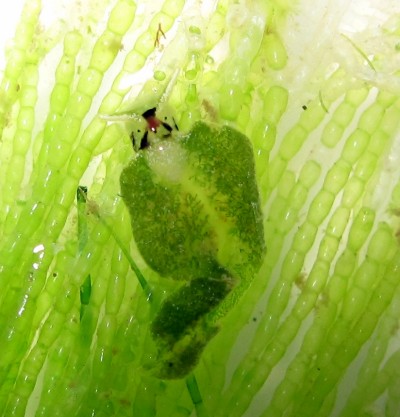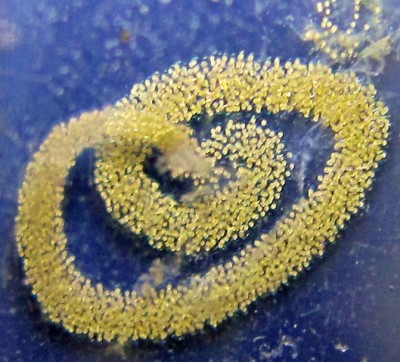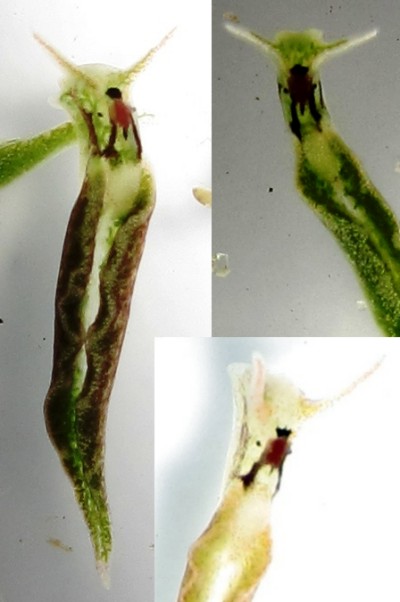Re: Elysia hirasei? from Ratnagiri
November 4, 2009
From: Vishal Bhave


Concerning message #22738:
Dear Bill,
I also contacted Kathe Jensen who thinks the specimen is Elysia hirasei. and she hoped some Japanese experts more familiar with the species could confirm it on the Seaslugforum
But, I think the red spot in mid head region is distinct as I have collected around 60+ specimens from many localities of Maharashtra, India, feeding on various algae (Chaetomorpha cf. media, Ulva sp., Enteromorpha sp.). Yestrday we collected them on bryozoans and other rocky substrates.
All those specimen has got the distinct Black markings (3 bands between rhinophores) with reddish-orange spot on central band in between 2 black bands . There is also a distinctive black patch on each side running forward above the eye.
Size ranges from 1.5 mm. (that is what i can observe ) to 9 mm.
Locality: Ratnagiri, Kunkeshwar, Undi - Ratnagiri; Vayangani, Vada-vetye-Sindhudurga, 10-15 centimeters, Maharashtra, India, Arabian sea, 19 October 2009, Intertidal, beneath the rock, on algae, in rockpool. Length: 02-08 mm. Photographer: Vishal Bhave.
Vishal Bhave
vishalbhave@gmail.com
Bhave, V.J., 2009 (Nov 4) Re: Elysia hirasei? from Ratnagiri. [Message in] Sea Slug Forum. Australian Museum, Sydney. Available from http://www.seaslugforum.net/find/22747
Dear Vishal,
Thanks for the extra photos and your comments. I agree with Kathe Jensen that this is most probably E. hirasei. Identifying opisthobranchs is not an exact science even with a knowledge of their anatomy. The problem at present is that we know very little about most species. In the case of many species of Elysia we know little about their geographic distribution, their biology and natural history, or their colour variability. Colour variation can occur within a single population at a particular place and it can also occur between populations scattered over vast geographic distances. We also know that in some species the background colour can change depending on the colour of the algae they are eating, or whether they are starving or full of food. I guess the colour variation we can see in your animals - from green to brown to pale yellow - is a result of food colour.
Concerning the black markings. They are certainly the same, or very similar, to those of Japanese specimens of E. hirasei. The red-pink spot in your animals has not been reported from Japan, but is could be an example of geographic colour variation where isolated populations of a widespread species can develop differences in their colour pattern. Another interesting possibility is that this is another example of black pigmentation being replaced by pink or orange as occurs in a number of chromodorid species such as Chromodoris hamiltoni. Certainly in some of your photos the pinkish spot is almost black.
At this stage I think it is best to consider this species to be a form of E. hirasei. It may take years before we have a full picture of colour variability in this species - or group of species. At present the only records between Japan and India are those on the Forum from Hong Kong and Thailand. We clearly need more from India and Japan as well as the long coastline in between.
Best wishes,
Bill Rudman
Related messages
-
South African Elysia
From: Richard Barnes, April 8, 2010 -
Re: Elysia hirasei? from India
From: Vishal Bhave, November 3, 2009 -
Re: Identification of an Elysia from Hong Kong
From: Cynthia D. Trowbridge, January 23, 2009 -
Re: Identification of an Elysia from Hong Kong
From: Kathe R. Jensen, April 14, 2005 -
Identification of an Elysia from Hong Kong
From: Allen To, February 5, 2005
